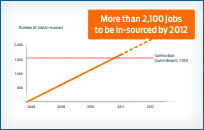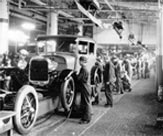In-Sourcing
Historical Background
At one time in Ford’s history, most, if not all, of the vehicle was assembled in one location. Cost and quality were the drivers behind these practices back in the early decades of the 20th Century. Keeping commodities and materials close to the plant lowered shipping costs. And by keeping all aspects of production in house, Ford could better control quality as well.
In-Sourcing Progress
-
With our new competitive labor rate, we have opportunities to bring work back into U.S. plants.
This practice began to change as vehicle components, and their production, became more complex and sophisticated. Some of the components, and the commodities needed to produce them, became simply too expensive to maintain inside the plant. These sourcing trends, combined with rising labor rates, compelled us to outsource some work from our plants to suppliers, so assembly plants could focus purely on final assembly, for example.
Big Changes in 2007
These outsourcing trends continued for decades and only recently began to change because of a transformational national labor contract negotiated in 2007 between Ford and the UAW that helped provide the company with more competitive labor costs. This agreement made a number of changes, which enabled Ford to lower our labor cost, including allowing us to designate a percentage of our newly hired hourly employees — 20 percent —as entry level employees, earning a lower base wage and some differences in benefits compared to existing seniority employees. This enables us to blend our overall labor rate, providing a much more competitive business case for bringing work back inside our plants. These are potential UAW jobs that until now have been outsourced to suppliers.
As of today, Ford plans to in-source more than 2,100 jobs by 2012, exceeding by roughly 35 percent the original contractual commitment to bring 1,559 jobs back to UAW-Ford employees through 2011.
We’ve committed to in-source jobs to the majority of our assembly, powertrain and stamping facilities around the country, including:
- Sharonville (Ohio) Transmission Plant for 6F35 automatic transmission gear machining and solenoid body assembly.
- Michigan Assembly Plant in Wayne, Mich., for moon roof sub-assembly, instrument panel assembly and part kitting for engine, doors and interior trim for the company’s new Ford Focus, which has begun arriving in dealerships.
- Chicago Stamping Plant for a variety of stamped parts for the Lincoln MKS and Ford Taurus, as well as for next generation Ford Explorer.
- Sterling Plant in Sterling Heights, Mich., for global production of the Rear Drive Unit for Ford’s front-wheel drive products.
- Van Dyke Transmission Plant in Sterling Heights for production of the 6F35 automatic transmission and HF35 electric drive transaxle. The work is currently performed by a supplier in Japan.
- Rawsonville Plant in Ypsilanti, Mich., for battery pack assembly for next-generation hybrid-electric vehicles. The work is currently performed by a supplier in Mexico.
Opportunities Ahead
With Ford’s new competitive labor rate, there are many more opportunities to bring work back into U.S. plants. In-sourcing allows Ford to hedge against currency fluctuations and rising commodity prices, such as oil. It also helps us mitigate unforeseen supply chain interruptions due to global instability. And it helps us achieve “just in time” production and minimize our inventory levels.
Keeping all aspects of manufacturing close to or inside our plants and creating the jobs that come with the work is good for Ford, the UAW and the communities in which we do business.












